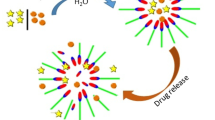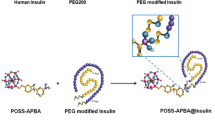Abstract
Metformin hydrochloride (Metf) is a first-line oral drug for the treatment of type 2 diabetes and it is primarily absorbed in the small intestine. However, it degrades easily before reaching the intestine, so its use is limited. In order to solve this problem, the supramolecular nanoparticles were successfully constructed based on electrostatic interaction of cationic β-CD derivative (DPN-β-CD and anionic surfactant sodium dodecylbenzene sulfonate (SDBS). The nanoparticles were characterized by UV–visible absorption, X-ray diffraction, dynamic light scattering, transmission electron microscopy and zeta potential techniques. The average diameter of the obtained nanoparticles is 254 nm, the main structure is spherical, and they are uniformly distributed in solution with a zeta potential of − 9.04 mV. Subsequently, it was found that the obtained nanoparticles can be disassembled by increasing the pH and reassembled by reducing to the initial pH value. The SDBS/DPN-β-CD supramolecular nanoparticles can efficiently encapsulate model diabetes drug such as Metf. More importantly, the in vitro release at different physiological pH values of 2.0, 6.3 and 8.0 showed a controlled release of Metf from the system and the release rate of Metf is lower in a simulated gastric environment (pH 2.0), while the release is higher in a simulated intestinal environment (pH 8.0). This system helps to reduce the stimulation of Metf to the stomach and improve its absorption rate in the small intestine. Therefore, the anti-diabetic small intestine specific drug delivery system is of potential importance in the treatment of diabetes.
Graphical abstract






Similar content being viewed by others
Data availability statement
The data that support the findings of this study are available from the corresponding author upon reasonable request.
References
Artasensi A, Pedretti A, Vistoli G (2020) Type 2 diabetes mellitus: a review of multi-target drugs. Molecules 25:1987
Packer M (2018) Is metformin beneficial for heart failure in patients with type 2 diabetes? Diabetes Res Clin Pract 136:168–170
Smith JD, Mills Eand Carlisle SE (2016) Treatment of pediatric type 2 diabetes. Ann Pharmacother 50:768–777
Migdadi EM, Courtenay AJ, Tekko IA (2018) Hydrogel-forming microneedles enhance transdermal delivery of metformin hydrochloride. J Control Release 285:142–151
Zaghloul AA, Lila A, Abd-Allah F (2017) Preparation and in vitro/in vivo evaluation of metformin hydrochloride rectal dosage forms for treatment of patients with type II diabetes. J Drug Target 25:463–470
Zhang J, Zhou ZH, Li L (2020) Dual stimuli-responsive supramolecular self-assemblies based on the host-guest interaction between beta-cyclodextrin and azobenzene for cellular drug release. Mol Pharm 17:1100–1113
Farjadian F, Ghasemi S, Andami Z (2020) Thermo-responsive nanocarrier based on poly(N-isopropylacrylamide) serving as a smart doxorubicin delivery system. Iran Polym J 29:197–207
Liu YN, Qu R, Li X (2021) Integration of catalytic capability and pH-responsive wettability in a VxOy-based dual-mesh system: towards solving the trade-off between the separation flow rate and degradation efficiency. J Mater Chem A 9:5454–5467
Zou YQ, Hu B, Chen L (2020) Novel pH- and thermoresponsive supramolecular dendronized copolymer. Iran Polym J 30:47–56
Spinelli E, Requena T, Caruso M (2020) Fate of methicillin-resistant staphylococcus aureus (MRSA) under simulated acidic conditions of the human stomach. Food Sci Nutr 8:4739–4745
Saini M, GhoshS KV (2020) Selective release of doxorubicin from cucurbit[8]uril stabilized gold supra-pyramid host at pH of small intestine. Chem Eur J 26:15150–15158
Zhu J, Huo Q, Liu Y (2018) Bortezomib-catechol conjugated prodrug micelles: combining bone targeting and aryl boronate-based pH-responsive drug release for cancer bone-metastasis therapy. Nanoscale 10:18387–18397
Proksch E (2018) pH in nature, humans and skin. J Dermatol 45:1044–1052
Zhu H, Shangguan L, Huang F (2018) Recent progress in macrocyclic amphiphiles and macrocyclic host-based supra-amphiphiles. Mater Chem Front 2:2152–2174
Nakamura H, Iwamori H, Hirahara Y (2019) Geochemical mapping of slab-derived fluid and source mantle along Japan arcs. Gondwana Res 70:36–49
Chakraborty G, Singh PK, Pal H (2021) A cationic cyclodextrin assisted aggregation of an anionic pyrene derivative and its stimuli responsive behavior. J MolLiq 321:114499
Gannimani R, Walvekar P, Govender T (2020) Acetal containing polymers as pH-responsive nano-drug delivery systems. J Control Release 328:736–761
Zhang YH, Zhang YM, Liu Y (2019) Boronate-crosslinked polysaccharide conjugates for pH-responsive and targeted drug delivery. Chem Commun 55:1164–1167
Yan Y, Ding H (2020) pH-responsive nanoparticles for cancer immunotherapy: a brief review. Nanomaterials 10:1613
Zhao J, Zheng D, Lei J (2020) Self-assembled pH-responsive polymeric nanoparticles based on lignin-histidine conjugate with small particle size for efficient delivery of anti-tumor drugs. Biochem Eng J 156:107526
Yue L, Li J, Zhao Y (2020) Host-guest interaction between 20(S)-protopanaxatriol and three polyamine-modified β-cyclodextrins: preparation, characterization, inclusion modes, and solubilization. J Inclus Phenom Macrocyclic Chem 97:29–42
Shi RJ, Chen Y, Liu Y (2016) Effect of head/tail groups on molecular induced aggregation of polycationic cyclodextrin towards anionic surfactants. Rsc Adv 6:15175–15179
Li JJ, Zhang HY, Liu Y (2019) Roomtemperature phosphorescence and reversible white light switch based on a cyclodextrin polypseudorotaxane xerogel. Adv Opt Mater 7:1900589
Liu J, Liu X, Wang L (2018) Supramolecular modular approach toward conveniently constructing and multifunctioning a pH/redox dual-responsive drug delivery nanoplatform for improved cancer chemotherapy. ACS Appl Mater Interfaces 10:26473–26484
Rençber S, Gündoğdu E, Başpınar Y (2021) Preparation and characterization of mucoadhesive gels containing pentoxifylline loaded nanoparticles for vaginal delivery of genital ulcer. Iran Polym J 30:569–582
Yew HC, Misran M (2016) Preparation and characterization of pH dependent κ-carrageenan-chitosan nanoparticle as potential slow release delivery carrier. Iran Polym J 25:1037–1046
Yue L, Jin W, Zhao Y (2020) pH-responsive chitosan/sulfobutyl ether-β-cyclodextrin supramolecular nanoparticles for controlled release of sodium ferulate. Polym Eng Sci 60:2403–2413
Duan Z, Gao YJ, Wang H (2015) pH-sensitive polymer assisted self-aggregation of bis(pyrene) in living cells in situ with turn-on fluorescence. Nanotechnology 26:355703
Chen SL, Li ZW, Zhao Y (2020) Preparation, characterization and solubilization evaluation of two novel host-guest complexes based on two different functional groups of modified β-cyclodextrins and 20(S)-protopanaxatriol. J Mol Struct 1204:127494
Chen XY, Yang HW, Zhao Y (2021) Solubility and biological activity enhancement of docetaxel via formation of inclusion complexes with three alkylenediamine-modified β-cyclodextrins. RSC Adv 11:6292–6303
Acknowledgements
This work was supported by the National Natural Science Foundations (Nos. 21961046, 21362046, and 21062030), which are gratefully acknowledged.
Author information
Authors and Affiliations
Corresponding author
Ethics declarations
Conflict of interest
There are no conflicts to declare.
Supplementary Information
Below is the link to the electronic supplementary material.
Rights and permissions
About this article
Cite this article
Teng, J., Chen, S., Zhang, J. et al. pH-responsive nanoparticles based on sodium dodecylbenzene sulfonate and polyamine-modified cyclodextrins for controlled release of metformin hydrochloride. Iran Polym J 31, 1069–1078 (2022). https://doi.org/10.1007/s13726-022-01060-w
Received:
Accepted:
Published:
Issue Date:
DOI: https://doi.org/10.1007/s13726-022-01060-w




